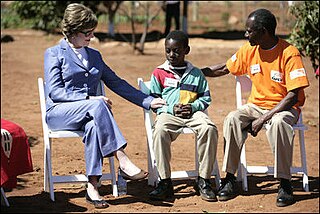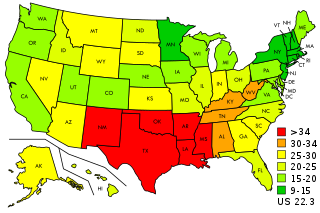
Teenage pregnancy, also known as adolescent pregnancy, is pregnancy in a female adolescent or young adult under the age of 20. Worldwide, pregnancy complications are the leading cause of death for women and girls 15 to 19 years old. The definition of teenage pregnancy includes those who are legally considered adults in their country. The WHO defines adolescence as the period between the ages of 10 and 19 years. Pregnancy can occur with sexual intercourse after the start of ovulation, which can happen before the first menstrual period (menarche). In healthy, well-nourished girls, the first period usually takes place between the ages of 12 and 13.

Family planning is the consideration of the number of children a person wishes to have, including the choice to have no children, and the age at which they wish to have them. Things that may play a role on family planning decisions include marital situation, career or work considerations, financial situations. If sexually active, family planning may involve the use of contraception and other techniques to control the timing of reproduction.

Birth rate, also known as natality, is the total number of live human births per 1,000 population for a given period divided by the length of the period in years. The number of live births is normally taken from a universal registration system for births; population counts from a census, and estimation through specialized demographic techniques. The birth rate is used to calculate population growth. The estimated average population may be taken as the mid-year population.

Sexual and reproductive health (SRH) is a field of research, health care, and social activism that explores the health of an individual's reproductive system and sexual well-being during all stages of their life. Sexual and reproductive health is more commonly defined as sexual and reproductive health and rights, to encompass individual agency to make choices about their sexual and reproductive lives.

Abstinence-only sex education is a form of sex education that teaches not having sex outside of marriage. It often excludes other types of sexual and reproductive health education, such as birth control and safe sex. In contrast, comprehensive sex education covers the use of birth control and sexual abstinence.
Adolescent sexuality is a stage of human development in which adolescents experience and explore sexual feelings. Interest in sexuality intensifies during the onset of puberty, and sexuality is often a vital aspect of teenagers' lives. Sexual interest may be expressed in a number of ways, such as flirting, kissing, masturbation, or having sex with a partner. Sexual interest among adolescents, as among adults, can vary greatly, and is influenced by cultural norms and mores, sex education, as well as comprehensive sexuality education provided, sexual orientation, and social controls such as age-of-consent laws.
The sexuality of US adolescents includes their feelings, behaviors and development, and the place adolescent sexuality has in American society, including the response of the government, educators, parents, and other interested groups.
Teenage pregnancy in the United Kingdom refers to the rate at which people under 20 fall pregnant in the United Kingdom. As of 2021, the rate of teenage conceptions in the United Kingdom was 5.226% percent of total conceptions, whereas 2.199% of all live births in the United Kingdom were to mothers under 20 years of age. The rate of teenage pregnancy is relatively high when compared with other developed countries; the only other Western countries with higher teenage pregnancy rates are the United States and New Zealand. A report in 2002 found that around half of all conceptions to under-18s were concentrated among the 30% most economically deprived population, with only 14% occurring among the 30% least deprived.
Abortion in Iceland is legal on request until the end of the 22nd week of pregnancy. The abortion rate in Iceland is relatively high, in comparison to other Nordic countries.
Long-acting reversible contraceptives (LARC) are methods of birth control that provide effective contraception for an extended period without requiring user action. They include injections, intrauterine devices (IUDs), and subdermal contraceptive implants. They are the most effective reversible methods of contraception because their efficacy is not reliant on patient compliance. The typical use failure rates of IUDs and implants, less than 1% per year, are about the same as perfect use failure rates.

Birth control, also known as contraception, anticonception, and fertility control, is the use of methods or devices to prevent unintended pregnancy. Birth control has been used since ancient times, but effective and safe methods of birth control only became available in the 20th century. Planning, making available, and using human birth control is called family planning. Some cultures limit or discourage access to birth control because they consider it to be morally, religiously, or politically undesirable.
Unintended pregnancies are pregnancies that are mistimed, unplanned or unwanted at the time of conception.

16 and Pregnant is an American reality television series that aired from June 11, 2009, to July 1, 2014, on the cable channel MTV. It followed the stories of pregnant teenage girls in high school dealing with the hardships of teenage pregnancy. Each episode featured a different teenage girl, with the episode typically beginning when she is 4+1⁄2 – 8 months into her pregnancy. The episode typically ends when the baby is a few months old. The series is produced in a documentary format, with an animation on notebook paper showing highlights during each episode preceding the commercial breaks. 16 and Pregnant has spawned five spin-off series: Teen Mom, Teen Mom 2, Teen Mom 3, Teen Mom: Young and Pregnant, and 16 and Recovering, which premiered on September 1, 2020.

Family planning in India is based on efforts largely sponsored by the Indian government. From 1965 to 2009, contraceptive usage has more than tripled and the fertility rate has more than halved, but the national fertility rate in absolute numbers remains high, causing concern for long-term population growth. India adds up to 1,000,000 people to its population every 20 days. Extensive family planning has become a priority in an effort to curb the projected population of two billion by the end of the twenty-first century.
Pregnancy is a potential result of rape. It has been studied in the context of war, particularly as a tool for genocide, as well as in other unrelated contexts, such as rape by a stranger, statutory rape, incest, and underage pregnancy. The current scientific consensus is that rape is at least as likely to lead to pregnancy as consensual sexual intercourse, with some studies suggesting rape may actually result in higher rates of pregnancy than consensual intercourse.
Abortion in Cuba is legal and available upon request, which is rare in Latin America because of widespread Catholic influence.

Access to safe and adequate sexual and reproductive healthcare constitutes part of the Universal Declaration of Human Rights, as upheld by the United Nations.

Teenage pregnancy in the United States occurs mostly unintentionally and out of wedlock but has been declining almost continuously since the 1990s. In 2022, it fell to 13.5 per 1,000 girls aged 15 to 19, the lowest on record. According to the Centers for Disease Control and Prevention (CDC), this decline is due to abstinence and the use of contraception. However, the averages conceal significant ethnic or geographic differences within the nation. The birth rates for Hispanic and African-American teens were more than double those of European-American teens, while Asian-American adolescents have the lowest pregnancy and birth rates of all. As of 2015, New Mexico, Texas, Oklahoma, Arkansas, Louisiana, and Mississippi had the highest adolescent birth rates in the Union.
Teenage pregnancy is a girl between the ages of 13 and 19 becoming pregnant. The term used in every day speech usually refers to girls who have not yet reached legal adulthood, which in Australia is anyone under the age of 18. At the national level, the teenage birth rate has declined in the last decade. The rate was about 16 babies per 1,000 women aged 15–19 years between 2011 and 2012 but this had fallen to 11.9 births per 1,000 women aged 15–19 in 2015, the lowest figure on record. Terminations can be performed up until the 12-week mark. About half of all teenage pregnancies are terminated in Australia.
Adolescent sexuality has been a topic observed and studied within the United Kingdom throughout the 20th century and in the 21st century. Associated organisations have been established to study and monitor trends and statistics as well as provide support and guidance to adolescents.














